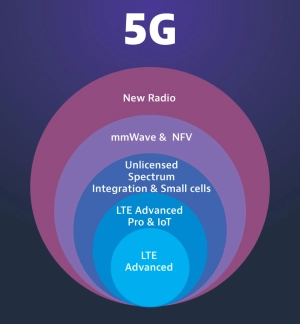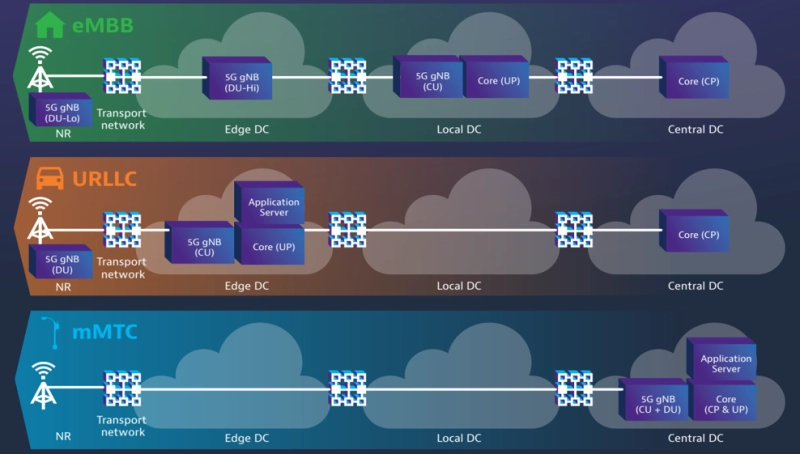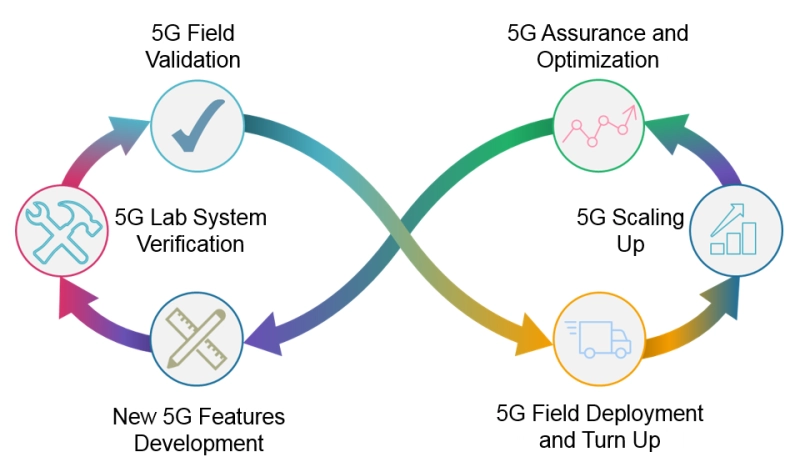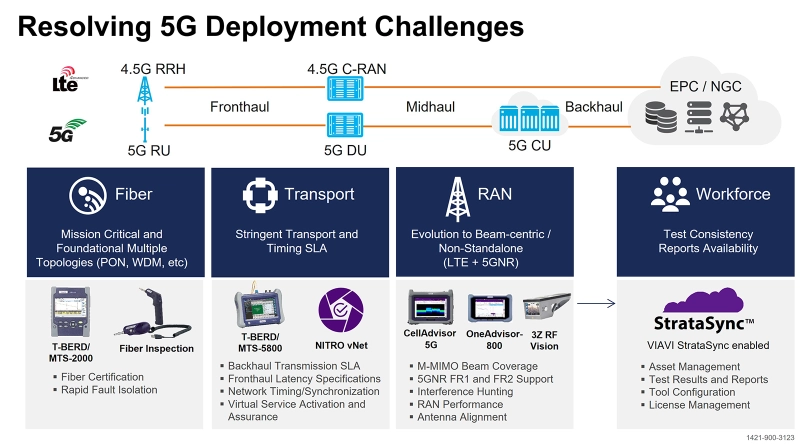What is 5G Testing?
Learn everything there is to know about testing 5G networks, including why it's so important, the various phases of deployment, and best practices for testing.
New innovations such as self-driving cars, the “Internet of Things” (IoT) and virtual reality are driving the next paradigm shift, and 5G will provide the exponential improvement in bandwidth and latency reduction to power these advancements.
People demand the best in performance when it comes to wireless technology. New 5G advancements allow speeds up to 100 times faster than existing cellular connections and latency in the 1 millisecond range, 5G will even surpass the current capabilities of physical fiber optics.
To support a successful transition, 5G test practices are being developed and refined to ensure the consistent 5G performance that end-users demand. The collective tools, software, protocols, and practices required for all 5G deployment phases form the core of the emerging 5G testing field.
5G testing means more than verifying the lightning-fast download speeds, super low latency and expansive coverage density. Simplified, end-to-end 5G test solutions are playing a vital role in the development, deployment, and operational excellence of emerging 5G networks. The unparalleled test process automation experience and expertise ranging from the lab to the field from VIAVI is unlocking improved visibility, faster time-to-market and optimized 5G revenue streams.
All big changes require commitment, and 5G performance is no exception. The new architectural elements that define 5G bring complexity and technical challenges to the test arena commensurate with the 5G New Radio level of innovation. VIAVI is a company at the helm of 5G protocol testing and has created a comprehensive and fully-integrated 5G network testing selection of cloud-enabled test devices and equipment, software automation services and network test solutions. For developers, operators and their partners, this commitment to 5G performance and service has translated to successful deployments and sustainable 5G network assurance.
Read on to discover how the importance and challenges of 5G testing continue throughout all deployment phases.
Why 5G Testing Is Important
5G testing has become a critical enabler of 5G potential. Test solutions have quickly adapted to complex use cases and wholesale architectural advancements encompassing core, transport, RAN and fiber network elements simultaneously. This has necessitated advanced emulation and verification technology in the 5G test lab that is scalable to full 5G deployment in the field.
5G fiber networks are being challenged to meet fronthaul and backhaul demands with the bar set higher for speed, bandwidth, reliability and synchronization while network function virtualization (NFV) and edge computing introduce additional visibility obstacles. This convergence of dynamic system elements makes automated, real-time intelligence platforms another important pillar of 5G network performance testing and optimization necessary to put your 5G solution in place.
New Radio (NR)

5G NR refers to the new OFDM-based wireless standard that will supersede LTE as the de facto standard for 5G operation. The 3rd Generation Partnership Project (3GPP) released the preliminary NR standard in December 2017. The New Radio spectrum will include frequencies from less than 6 GHz up to 100 GHz. Much of this wide spectrum will consist of space vacated by decommissioned 2G, 3G, and PCS frequency bands for the sub 6GHz band. The first application to be addressed and standardized will be mobile broadband. Additional capabilities, such as massive machine type communications (MMTC) and ultra-reliable low latency communications (URLLC) will be rolled out later.
5G NR is driving a new paradigm in 5G test methodology. An elevated degree of sophistication is required to verify beam tracking and acquisition at higher frequencies with more complex channel aggregation. Flexible 5G RAN architecture produces an exponentially larger set of test cases and diverse fiber network configurations. At the same time, coexistence with 4G in non-standalone mode creates interference and handoff issues that must also be emulated, tested and verified, and monitored through innovative 5G test practices.
Millimeter Wave
The super-high frequency spectrum that includes the 100 GHz upper limit defined by NR is known as millimeter wave. Large amounts of available bandwidth in hundreds of MHz at higher frequency translates to higher speed; the millimeter range, defined as 24 GHz to 100GHz, is an essential element of 5G testing and deployment. While the speed is faster, the range is much shorter, and obstacles such as buildings and walls will blunt the signal, whereas lower frequencies can simply travel through these objects. These higher frequencies and wider channel bandwidths have necessitated test solutions with improved dynamic range and signal-to-noise ratios (SNR) to demodulate signals in the millimeter wave accurately.
Massive MIMO
Multiple input, multiple output, or MIMO refers to antenna technology that can be used to increase the data rate (spatial multiplexing) instead of improving robustness. A system that incorporates a much larger number of radio antennas into arrays on cellular towers is referred to as massive MIMO. At high frequencies, radio wavelengths are so small that a large array of antennas can be integrated into a much smaller form factor to allow massive MIMO operation.
Massive MIMO can overcome some of the drawbacks associated with millimeter wave by transmitting data streams in parallel and enabling the device to reconstitute them into a single message. Massive MIMO array density and elimination of connector ports has prohibited traditional cabled testing and ushered in new over-the-air (OTA) 5G test standards.
This advanced functionality has landed synchronization testing requirements for 5G MIMO arrays into the most stringent (A+) category of tests. Fronthaul transport network node (FTN) testing with the T-BERD/MTS-5800-100G can effectively validate synchronization requirements by performing throughput, delay and packet jitter measurements.
Beamforming
Another advanced technology that is essential to the success of 5G testing and deployment is beamforming. This is a method whereby an algorithm is used to focus wireless signals into a directed beam. This approach provides a way to avoid obstacles that can interfere with high-frequency transmissions and can also strategically focus transmissions directly to the end user.
The use of massive MIMO will further enable this personalization through the propagation of dynamic arrays including 256 or more individual antennas. Validating these active antenna configurations along with channel performance requires innovative 5G test solutions for cell sites. The OneAdvisor 800 verifies and monitors channel stability, modulation quality and cell ID from controlled field trials through large-scale 5G deployments.
Network Slicing
The concept of network slicing refers to intelligently utilizing portions of the spectrum based on the specific needs of the individual device or application. For example, a self-driving car may require extremely low latency for safe operation, whereas IoT applications may encompass a large number of devices with very low throughput demands. The mobile network will adeptly configure resources to optimize traffic flow and resource utilization.
5G network performance verification of multiple, virtual elements in the real world can be augmented by testing and validating diverse network slicing use cases in the lab environment. End-to-end solutions for RAN-to-Core testing and validation can emulate 5G core networks in total and verify network slice node selection and functionality.

The combination of millimeter wave utilization, MIMO, and beamforming provides the infrastructure of 5G and the pathway to incredible performance enhancements for our evolving digital world. The added complexity introduced by these innovations can also pose challenges for 5G test networks as well as the overall 5G testing process. MIMO essentially means (many) more antennas, which equates to a higher burden for 5G testers to ensure all integrated antennas are fully operational. Measurement connectors for each antenna will no longer be feasible based on the compact architecture and density.
The utilization of the millimeter wave and beamforming at super-high frequencies presents additional obstacles. Since these frequencies are much more susceptible to propagation loss from environmental conditions, over-the-air (OTA) testing may be less consistent and more complex. However, since conducted mode testing cannot be performed without discrete connection points, OTA will be required more frequently to avoid limited results.
Channel emulation becomes more complex with 5G, since the number of necessary RF channels will exponentially increase, as opposed to the linear expansion experienced with 3G and 4G releases. For 5G test equipment to be practical, the electronics technology must advance rapidly to compensate for the intricacy. Creative solutions that minimize chamber testing and other expensive test elements, without compromising test coverage and accuracy, should continue to be explored in the market.
The deployment of 5G is a complex and challenging endeavor, requiring careful planning, many 5G test and measurement cycles, followed by seamless execution. Within each individual deployment phase, prudent application of an optimized 5G test toolkit is the best way to guarantee success. In many cases, these phases will be compressed and overlapping.
Phase #1 – Technology Verification and Validation
An essential precursor of successful 5G network deployment is robust verification and validation (V&V). This phase includes verification of virtual network functions and network services to ensure immediate quality and reliability once the network is deployed.
Scalable 5G testers with integrated data services are required to measure the complete performance of the network and simulate real-world user behavior in 5G field trials. Software capable of emulating and measuring millions of unique data flows is another indispensable element of 5G V&V which can enhance load/capacity testing and benchmarking capabilities.

Phase #2 – Deploy, Activate & Scale
Once the rubber of 5G deployment hits the road, an appropriate suite of 5G test equipment for activation and scalability is imperative. Base station analyzers augmented to analyze the spectrum and interference of 5G signals in the millimeter wave range are an important centerpiece for this deployment phase. Software to monitor and ensure network performance and verify Service Level Agreements can augment the 5G activation, performance monitoring, and troubleshooting activities.
Advanced fiber testing is an important element of the end-to-end 5G test process during deployment and activation. For example, through fiber optic cable runs, Centralized Radio Access Networks (C-RAN) can co-locate baseband unit locations away from busy antenna sites. C-RAN architecture can also help to facilitate real-time radio resource coordination.
Phase #3 – Assure, Optimize, Monetize
The opportunities for monetization through 5G connectivity are limitless. More so, 5G is about major business transformation, not just network transformation. Subscription fees for ultra-fast mobile broadband, mobile HD content and videos, virtual reality gaming, media streaming, and widespread IoT applications are just a few of the obvious avenues.
Each will require excellent customer quality of experience (QoE) to maintain viability. A real-time intelligence platform connected to virtual agents throughout the network lifecycle is an effective way to meet the challenges of 5G traffic density head-on, thereby assuring and optimizing QoE on a continuous basis.
Read more about your options for deploying 5G.

While the 3GPP has released the preliminary standard for 5G NR, there are still many areas in need of further refinement. Non-standalone (NSA) mode has been addressed in the 2017 release, although details regarding 5G standalone (SA) mode specifications, absent the convention of LTE coverage as an anchoring technology, have yet to be established.
Standardization is ultimately the key to developing accurate 5G test models, which in turn lead to more harmonized test practices. With the LTE standard now adopted worldwide for phones and other mobile devices, there is every reason to anticipate a similar evolution for 5G testing best practices.
Given the enormous frequency range and high-bandwidth services inherent to 5G technology, standardization of best practices will continue to progress as the technology, tools, and applications develop.
Industry-Leading 5G Test Equipment
The technological advancements that 5G has enabled were once the stuff of science fiction. Autonomous cars, virtual reality gaming, “smart cities” and the IoT are just a few of the futuristic innovations with a long head start as they incorporate the bandwidth and latency improvements of 5G technology. As with any advancement in functional capability, the unlimited potential of 5G will spawn more creativity and a continuous stream of new applications.
This innovative energy ensures the deployment of 5G networks will continue to propagate as the migration towards standalone mode has begun to take shape. The challenges ahead mean demand for innovative and cost-effective 5G test equipment will continue unabated.
Since 2013, VIAVI has been an early driver in 5G adoption, partnering with the world’s top communication providers and network equipment manufacturers while delivering industry-leading solutions to customers year after year. The comprehensive portfolio of 5G test tools supports all phases of 5G deployment, with the adaptability required to assure quality and performance across all facets of the 5G landscape, making VIAVI a stand out amongst 5g testing companies. These powerful yet versatile test solutions tacitly support the greatest technology revolution of the 21st century.
Learn about 5G Testing
Learn about VIAVI 5G Testing Equipment today!
Are you ready to take the next step with one of our 5G test products or solutions?
Complete one of the following forms to find your 5G solutions:
